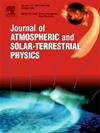Boosting total electron content forecasting based on deep learning toward an operational service
IF 1.8
4区 地球科学
Q3 GEOCHEMISTRY & GEOPHYSICS
Journal of Atmospheric and Solar-Terrestrial Physics
Pub Date : 2025-01-16
DOI:10.1016/j.jastp.2025.106427
引用次数: 0
Abstract
We present a prediction model based on deep learning able to forecast ionospheric Total Electron Content at global level 24 h in advance. It has been conceived to operate under different space weather scenarios and in an operational framework. Three different deep learning (DL) techniques have been compared: Long Short Term Memory (LSTM), Gated Recurrent Units (GRU) and Convolutional Neural Networks (CNN). The modelling approach inherits by and extends what has been proposed by Cesaroni and co-authors (2020a). Specifically, the machine learning-based approach here reported is conceived to improve the first step of Cesaroni et al. (2020a), in which TEC is forecasted on 18 selected grid points of Global Ionospheric Maps (GIMs) using the geomagnetic global index Kp index as the external input.
CNN models provide better predictive capabilities than LSTM and GRU, and it has more robust behaviour under different space weather conditions. We also show how all the proposed models outperform the two naive models: the so-called “frozen ionosphere” or recurrence model and a 27 days averaged model.
The novelty of our approach is the operational capability based on an incremental learning method to prevent the aging of the trained models by updating the weights with little computational effort adding new information immediately after the 24-h forecasting. The improvement changed from RMSE of ∼6.5 TECu to ∼2.5 TECu.We also discuss limitations and the use of other space weather inputs (e.g. solar proxies, other geomagnetic indexes, etc) and the use of complementary data science techniques (e.g. data preparation, hyperparameter tuning, better data resolution, etc.) to enhance the forecasting in future works.
将基于深度学习的总电子含量预测推向运营服务
提出了一种基于深度学习的电离层总电子含量预测模型,能够提前24 h预测全球电离层总电子含量。它的设想是在不同的空间天气情况下和在一个操作框架内运行。本文比较了三种不同的深度学习(DL)技术:长短期记忆(LSTM)、门控循环单元(GRU)和卷积神经网络(CNN)。建模方法继承并扩展了Cesaroni及其合著者(2020a)提出的方法。具体来说,本文报道的基于机器学习的方法被认为是为了改进Cesaroni等人(2020a)的第一步,其中使用地磁全球指数Kp指数作为外部输入,在全球电离层地图(GIMs)的18个选定网格点上预测TEC。CNN模型比LSTM和GRU具有更好的预测能力,在不同的空间天气条件下具有更强的鲁棒性。我们还展示了所有提出的模型如何优于两种朴素模型:所谓的“冻结电离层”或递归模型和27天平均模型。该方法的新颖之处在于基于增量学习方法的操作能力,通过在24小时预测后立即添加新信息,以很少的计算量更新权重来防止训练模型的老化。改善的RMSE从~ 6.5 TECu变化到~ 2.5 TECu。我们还讨论了其他空间天气输入(如太阳代理,其他地磁指数等)的局限性和使用,以及补充数据科学技术(如数据准备,超参数调整,更好的数据分辨率等)的使用,以增强未来工作中的预测。
本文章由计算机程序翻译,如有差异,请以英文原文为准。
求助全文
约1分钟内获得全文
求助全文
来源期刊

Journal of Atmospheric and Solar-Terrestrial Physics
地学-地球化学与地球物理
CiteScore
4.10
自引率
5.30%
发文量
95
审稿时长
6 months
期刊介绍:
The Journal of Atmospheric and Solar-Terrestrial Physics (JASTP) is an international journal concerned with the inter-disciplinary science of the Earth''s atmospheric and space environment, especially the highly varied and highly variable physical phenomena that occur in this natural laboratory and the processes that couple them.
The journal covers the physical processes operating in the troposphere, stratosphere, mesosphere, thermosphere, ionosphere, magnetosphere, the Sun, interplanetary medium, and heliosphere. Phenomena occurring in other "spheres", solar influences on climate, and supporting laboratory measurements are also considered. The journal deals especially with the coupling between the different regions.
Solar flares, coronal mass ejections, and other energetic events on the Sun create interesting and important perturbations in the near-Earth space environment. The physics of such "space weather" is central to the Journal of Atmospheric and Solar-Terrestrial Physics and the journal welcomes papers that lead in the direction of a predictive understanding of the coupled system. Regarding the upper atmosphere, the subjects of aeronomy, geomagnetism and geoelectricity, auroral phenomena, radio wave propagation, and plasma instabilities, are examples within the broad field of solar-terrestrial physics which emphasise the energy exchange between the solar wind, the magnetospheric and ionospheric plasmas, and the neutral gas. In the lower atmosphere, topics covered range from mesoscale to global scale dynamics, to atmospheric electricity, lightning and its effects, and to anthropogenic changes.
 求助内容:
求助内容: 应助结果提醒方式:
应助结果提醒方式:


